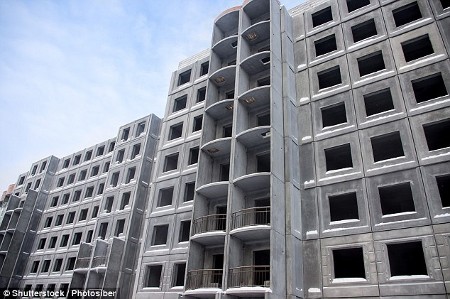Next to water comes concrete as a consumable states an article by Sophie Bushwick appearing in the July 19, 2021 issue of Scientific American. Comparing consumption in cubic metres gives us the following:
- Water – over 9 billion cubic metres annually.
- Concrete – over 4.16 billion cubic metres annually.
No other Earth material usage matches these two. But unlike water which is essential to life on Earth, concrete materials have a Jekyll and Hyde relationship with us. The Jekyll side of concrete is its use in almost everything humans build on the planet. Its Hyde side is the amount of greenhouse gas emissions created when we produce it.
Today’s process of producing concrete begins with the mining of raw limestone and clay which is then crushed, mixed with other materials and then fed into kilns to be heated to 1,450 Celsius (2,640 Fahrenheit) degrees. The output yields clinkers, a greyish chunky output that is cooled, ground, and mixed with additional limestone and gypsum to make the raw cement that goes into concrete. The industrial process produces lots of carbon dioxide (CO2) amounting to 8% of total greenhouse gasses emitted into the atmosphere today.
For those who raise the issue of water vapour being a far more visible greenhouse gas, it should be noted that Earth’s atmosphere long ago accommodated the water cycle. What the atmosphere, in accommodating today’s industrial emissions, is doing is heating up with concrete representing number four in the list of biggest greenhouse gas sources, trailing only coal, oil, and natural gas.
Concrete producers are well aware of the Paris Climate Agreement and the goal of countries and the industry to achieve net-zero emissions by 2050 and to be in negative emissions after that to draw down on existing CO2 in the atmosphere. What that means is a dramatic change in every aspect of the production process. Retrofitting older cement plants to burn blue and green hydrogen as fuel for kilns is one solution. Capturing CO2 is another.
A company based in Canada has made CO2 part of its end product. CarbonCure Technologies’ recipe for concrete turns its finished concrete blocks and pavers into a carbon sink. Another company, HeidelbergCement, a German company recently announced plans to build the first CO2-neutral cement plant in the world to be located in Sweden and operational by 2030.
The alternative to these types of solutions is for architects and builders to stop using concrete materials which would be better for the atmosphere, but for the industry, disastrous.
But what about all those concrete buildings and structures already in existence? Is there something that they can do to contribute to achieving a low-carbon future? Researchers may have come up with just the right idea: to turn concrete into rechargeable batteries.
Using concrete to store electricity is an idea that is gaining ground and although the material is far less efficient in storing electricity than traditional chemical and solid-state batteries, its abundance makes it a very attractive option. What would be great is to be able to turn existing concrete building inventories into battery storage for renewable energy producers. Imagine a building with solar arrays pumping out electricity and its concrete walls acting as battery backup when the sun is no longer shining.
We are not there yet, but Emma Qingnan Zhang and Lu-Ping Tang, of the Division of Building Technology, Department of Architecture and Civil Engineering, Chalmers University of Technology, in Gothenburg, Sweden, have a cement-based battery with energy densities of 7 Watt-hours per cubic metre. To use cement as a battery the researchers have incorporated anodes of iron and zinc, and cathodes of nickel-based oxides along with carbon fibres into the mix. And although their battery doesn’t generate a lot of power when compared to chemical and solid-state ones, with concrete as a primary construction material, turning buildings into storage batteries while serving as living accommodation would be a game-changer.
















